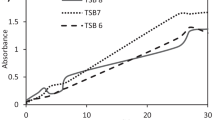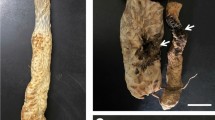Abstract
The strains capable of resistance against Verticillium dahliae Kleb were isolated and screened from the soils of cotton fields from several different provinces in China. A strain, coded DM-54, with a rather high antagonistic activity was obtained. Its morphological characteristics, physiological and biochemical properties and a 16 S rDNA sequence of this strain were further studied. The DM-54 strain was finally identified as a kind of Bacillus amyloliquefacien. Through a single factor experiment and an orthogonal experiment, the optimal shaking flask fermentation condition of strain DM-54 was found to be: media composed of 5% dextrin, 3% soy peptone, 0.02% MgSO4, 0.01% CaCl2, initial pH 7.0 and 10% inoculum volume, media volume 30/250 (mL/mL), fermentation temperature at 32°C, rotating speed 200 r·min−1, fermentation time of 48 h. Its antagonistic activity was distinguished to be elevated, at about 39.9%. Our research offers an effective means for the massive production of antagonistic proteins.
Similar content being viewed by others
References
Buchanan R E, Gibbons N E (1984). Bergey’s Manual of Determinative Bacteriology. Beijing: Science Press, 729–797
Cheng L J, Xue Q H, Lai H X (2000). Experimental Technology of Microbiology. Xi’an: World Publishing Corporation (in Chinese)
Dong X Z, Cai M Y (2001). Manual of systematic and Determinative Bacteriology. Beijing: Science Press, 349–388 (in Chinese)
Hu M (2004). Isolation, purification and characterization of an antifungal protein to Verticillium dahliae of cotton. Dissertation for the Master Degree. Baoding: University of Hebei, 14–18 (in Chinese)
Jiang Y, Huang L L, Chen C Q, Qiao H P, Kang Z S (2007). Screen, identification and optimized fermentation condition of an actinomycete strain against pathogenic fungus Fulvia fulva. Acta Microbiologica Sinica, 47(7): 622–627 (in Chinese)
Lane D J (1991). 16S/23S rRNA Sequencing. In: Stackebrandt E, Goodfellow, eds. Nucleic Acid Techniques in Bacteria Systematics. Chichester: John Wiley & Sons, 115–147 (in Chinese)
Li S Z, Ma P, Liu X Z, Huang H C, Chen X H (2001). Biological control of cotton verticillium wilt by antagonistic bacteria. Journal of Huazhong Agricultural University, 20(5): 42–425 (in Chinese)
Liang Q M, Qi D M, Jia J, Hui M, Niu T G (2005). Isolation of antagonistic Bacillus and purification of antifungal protein B110-a. Plant Protection, 8(5): 31–35 (in Chinese)
Quan C S, Wang J H, Xu H T, Fan S D (2006). Identification and characterization of a Bacillus amyloliquefaciens with high antifungal activity. Acta Microbiologica Sinica, 46(1): 7–12 (in Chinese)
Rainey F A, Ward-Rainey N, Kroppenstedt R M, Stackebrandt E (1996). The genus Nocardiopsis represents a phylogenetically coherent taxon and a distinct actinomycete lineage; proposal of Nocardiopsaceae fam. nov. International Journal of Systematic Bacteriology, 46: 1088–1092
Saitou N, Nei M (1987). The Neighbour-joining Method: a New Method for Reconstructing Phylogenetic Trees. Mol Biol Evol, 406–425
Sambong K, Jung Y, Hongik K (1995). A phylogenetic analysis of the genus Saccharomonospora conducted with 16 S rRNA gene sequences. International Journal of Systematic Bacteriology, 45(2): 351–356
Shen P, Fan X R, Li G W (1999). Microbiology Experiment. Beijing: Higher Education Press (in Chinese)
Xia Z J, Gu B K, Wu A M (1996). A study on the antagonistic activity of cotton to Verticillium dahliae induced by the endophytic bacteria in the ectohiaosphere and endorhizosphere of soil. Chinese Journal of Biological Control, 12(1): 7–10 (in Chinese)
Yang H, Cai LW, Pan Q B, Chen J P, Shi Q H, Zhang E, Wang H Y, Chen L M, Yang M F, Huo J Q (2006). Research advance of cotton verticillium wilt. Jiangxi Cotton, 28(6): 3–6 (in Chinese)
Zhou Y F, Du H F, Yuan H S, Zhang Y L, Zhu B C (2007). Isolation and purification of antifungal protein from Paenibacillus to Verticillium dahliae. Cotton Science, 19(2): 98–101 (in Chinese)
Zhou Y F, Zhao X Y, Zhang Y, Feng S L, Wang R Y (2006). Expression of Vitreoscilla hemoglobin gene in Bacillus thuringiensis. Journal of Hebei University (Natural Science Edition), 26(1): 33–37 (in Chinese)
Author information
Authors and Affiliations
Corresponding authors
About this article
Cite this article
Zhu, Y., Li, S., Yuan, H. et al. Isolation and identification of the antagonistic strain DM-54 of Bacillus amyloliquefacien against Verticillium dahliae, and optimization of antifungal protein producing conditions. Front. Agric. China 3, 16–23 (2009). https://doi.org/10.1007/s11703-009-0005-2
Received:
Accepted:
Published:
Issue Date:
DOI: https://doi.org/10.1007/s11703-009-0005-2




